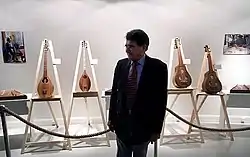Mohammad-Reza Shajarian
Mohammad-Reza Shajarian (Persian: محمدرضا شجريان; Persian pronunciation: [mohæmːæd ɾeˈzɒː ʃædʒæɾiˈɒːn], 23 September 1940 – 8 October 2020)[1] was an Iranian vocalist and master (Ostad) of Persian traditional music.[2][3][4] He was also known for his skills in Persian calligraphy and humanitarian activities.[5]
Mohammad-Reza Shajarian | |
|---|---|
محمدرضا شجریان | |
.jpg.webp) Shahjarian in 2007 | |
| Born | 23 September 1940 |
| Died | 8 October 2020 (aged 80) Tehran, Iran |
| Resting place | Tomb of Ferdowsi |
| Other names | Siavash Bidgani (before 1970s) |
| Education | Shah Reza School School of National Music |
| Alma mater | Tehran Supreme University |
| Occupation |
|
| Spouse(s) | Farkhondeh Golafshan
(m. 1962; div. 1993)Katayoun Khansari (m. 1995) |
| Children | 5, including Homayoun |
| Musical career | |
| Genres | Persian traditional music |
| Years active | 1959–2016 |
| Labels | Santur, Tonbak |
| Associated acts | Aref Ensemble |
| Website | mohammadrezashajarian |
| Signature | |
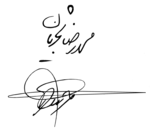 | |
Shajarian started his singing career in 1959 at Radio Khorasan, rising to prominence in the 1960s with his distinct style of singing. His main teachers were Ahmad Ebadi, Esmaeil Mehrtash, Abdollah Davami, and Nour-Ali Boroumand. He also learned the vocal styles of singers from previous generations, including Reza Gholi Mirza Zelli, Fariborz Manouchehri, Ghamar Molouk Vaziri, Eghbal Azar, and Taj Isfahani. He has cited legendary Persian tar soloist Jalil Shahnaz as highly influential to his development, indicating that he has often tried to mimic Shahnaz's playing style in his singing.
Shajarian had collaborated with musicians such as Parviz Meshkatian, Mohammad Reza Lotfi, Hossein Alizadeh, Faramarz Payvar, Dariush Pirniakan, and Sohrab Pournazeri. He was recognized as a skilled singer in the challenging traditional Dastgah style. In 1999, UNESCO in France presented him with the Picasso Award and in 2006 with the UNESCO Mozart Medal. In 2017, Los Angeles Times cited him as the "Greatest living maestro of Persian classical music".[6]
His works cover also some songs of Iranian ethnic music including Mazandarani music, Azeri music, Kurdish music and Lur music.
After coming out in support of the Iranian Green Movement and criticizing the Iranian government, he was banned from holding concerts and releasing music.[7][8][9]
Early life
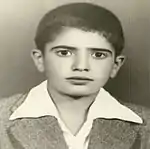
Mohammad-Reza Shajarian was born on 23 September 1940 in Mashhad, Iran. His father, Mehdi, was a Quran qari, as was his grandfather Ali Akbar. His mother was Afsar Shahverdiani, who died in 2007.[10][11]
He was the oldest of five siblings, and studied singing at the age of five under the supervision of his father by recitation of the Quran.[12]
Music career
Early work
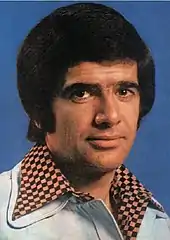
At the age of 12, he began studying the Persian classical repertoire known as the Radif without his father's consent as studying and performing music was against his father's religious beliefs.[13] This may have been the reason why he chose the stage name "Siavash Bidakani" in his early career as a singer, which did not last long, and soon he used his real name again.[14] Shajarian started his singing career in 1959 at Radio Khorasan, rising to prominence in the 1960s with his distinct style of singing.[15] Since then his career has included teaching at Tehran University's Department of Fine Arts, working at National Radio and television, researching Persian/Iranian music, and making numerous recordings.[16]
Music bands
Shajarian was not always in music groups, but he did the vocals for the Masters of Persian Music with his son Homayoun Shajarian, as well as two other ostads, Kayhan Kalhor and Hossein Alizadeh. He also performed with his daughter Mozhgan Shajarian.[17]
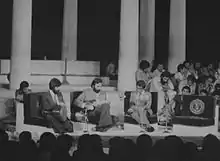
In 2008, he toured the world with the Ava Ensemble, composed of his son Homayoun (tombak and vocals), Hossein Behroozinia (barbat), Majid Derakhshani (tar), Hossain Rezaeenia (daf), and Saeed Farajpouri (kamanche).[18]
In 2012, he toured with the Shahnaz Ensemble with his daughter Mojgan and other band members. The ensemble is named after master tar musician Jalil Shahnaz, with a percentage of the proceeds going towards supporting his health care needs.[19]
Masters and students
Shajarian studied with Esmaeil Mehrtash, Ahmad Ebadi and Nour-Ali Boroumand. He learned the vocal styles of previous generations of singers such as Hossein Taherzadeh, Reza Gholi Mirza Zelli, Qamar-ol-Moluk Vaziri, Eghbal Azar and Taj Isfahani.[20] He started playing the santour under the instruction of Jalal Akhbari to better understand and perform the traditional repertoire.[21] In 1971, he was introduced to Faramarz Payvar and took santour lessons with him. Shajarian also learned Abolhasan Saba's vocal Radif from Payvar. He also studied under the guidance of master Abdollah Davami, from whom he learned many early Persian songs.[22] Davami also passed on to Shajarian his own interpretation of the Radif.[23]
Mohammad Reza Shajarian has taught many students in the field of singing, some of whom are:[24]
- Iraj Bastami
- Ali Jahandar
- Shahram Nazeri
- Hesameddin Seraj
- Muzaffar Shafei
- Qasem Rafati
- Mohammad Esfahani[25]
- Homayoun Shajarian
- Ali Rostamian
- Mohsen Keramati
- Hamid Reza Noorbakhsh
- Sina Sarlak
- Mojtaba Asgari
Significant works
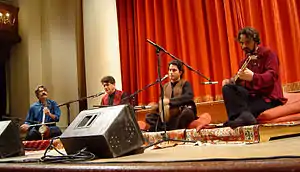
- Raast-Panjgaah concert with Mohammad Reza Lotfi in Raast-panjgaah (1976).
- Chehre be Chehre with Mohammad Reza Lotfi in Navaa (1977).[28]
- Golbang-e Shajarian, Part 1 (Bot-e Chin) features: Ali Akbar Sheida (Ballads), Fereydun Shahbazian](Composer), Faramarz Payvar (Santur), Hushang Zarif (Tar). Part 2 (Dowlat-e Eshq) features Hassan Yusefzamani (Composer), Ahmad Ebadi (Setar), AliAsghar Bahari (Kamancheh). Poetry by Hafez, Saadi and Baba Taher (1977).[29]
- Eshgh Daanad with Mohammad Reza Lotfi in Aboo Ataa (1981).
- Aastaan e Jaanaan with Parviz Meshkatian and Naaser Farhangfar in Bayaat e Zand (Turk) & Sur (1982).[30]
- Peyvande Mehr (album) with Farhang Sharif (1984).[31]
- Bidaad with Parviz Meshkatian and the Aref Ensemble in Homaayoun (1985).[32]
- Be yaad e Aaref with Mohammad Reza Lotfi in Bayaat e Turk (1986).
- Nava – Morakkab Khani with Parviz Meshkatian and the Aref Ensemble in Navaa, Se-gaah and Dashti (1986).
- Doud-e-Oud with Parviz Meshkatian and the Tehran Symphony Orchestra in Navaa (1987).[33]
- Dastan with Parviz Meshkatian and the Aref Ensemble in Chahaar-Gah (1987).[34]
- Dastgah Chahargah (live version of Dastan) concert with Parviz Meshkatian and the Aref Ensemble recorded live in Bonn (1987).
- Ghasedak with Parviz Meshkatian and Homayoun Shajarian (1994).
- Dar Khiaal with Majid Derakhshani in Segaah & Bayaat e Zand (Turk) (1995).
- Zemestaan Ast with Hossein Alizadeh and Keyhan Kalhor in Maahoor and Homaayoun (1999).[35]
- Night, Silence, Desert (Persian: Shab, Sokoot, Kavir) with Keyhan Kalhor based on the folk music of Khorasan. Traditional Crossroads (2000).
- Bi To Be Sar Nemishavad with the Masters of Persian Music Ensemble in Navaa and Bayaat e Kord (2002).[36]
- Faryaad with the Masters of Persian Music Ensemble in Raast-panjgaah (2003).
- Devoid Grail with Fereydoun Shahbazian in Mahour and Dashti (2004).
- Serr-e-Eshgh with Parviz Meshkatian and Mohammad Mousavi in Maahoor.
- Sepideh Album with Mohammad Reza Lotfi and Sheyda Ensemble in Maahoor.
- Cheshmeye Noush with Mohammad Reza Lotfi and Majid Khaladj in Raast-panjgaah.
Politics

Shajarian's Bidaad album was recorded after a three-year hiatus from commercial recording. The lyrics of the album speak of a wonderful place having been reduced to shambles and bloodshed, in which he sings in sadness "what happened?". When giving a lecture at California State University, Sacramento on 2 March 2012, he was asked what the lyrics of this song meant. His response made it clear that he chose these lyrics based on what happened to the Iranian regime in the aftermath of the revolution – a once beautiful country being reduced to shambles.[37] This is widely considered his first commercial recording meant to represent the voice of an oppressed people in Iran.
Shajarian has indicated support for Iranians protesting against the 12 June 2009 Iranian presidential election results. When Iran's president, Mahmoud Ahmadinejad referred to the protesters as "dust and trash", Shajarian told a BBC Persian channel telephone interviewer that he (Shajarian) considered himself the voice of dust and trash: "It is the voice of dust and trash and it will always remain the voice of dust and trash." He also asked IRIB (Islamic Republic of Iran Broadcasting) to stop broadcasting his songs. He mentioned that his famous song "Iran, Ey Saraye Omid" (Iran, the land of Hope), has no relation with the current situation of his country.[38]
In an interview in 1995, Shajarian stated that "my criticism was a mistake of one person, I am not against the republic system. Our music has always been attacked or criticized by a class of religious people. Of course, some of the deviant music can be like this. But the nature of music is not deviant. I myself am fundamentally opposed to deviant music. We accept the clergy and religion".[39]
Lyrics of his song "Language of Fire," issued in September 2009, — "Lay down your gun, Come, sit down, talk, hear. Perhaps the light of humanity will get through to your heart too" — are thought by some observers to speak "directly to the plainclothes Basiji militiamen and security forces" who had beaten protesters during recent unrest.[6]
In an interview with Hamid Reza Nourbakhsh in 2016, Shajarian said that he was not against the Islamic Republic and that his protest was only against one person (Mahmoud Ahmadinejad). "We say you have no right to insult the people. This is not a fall with the whole system."[40][41][42]
We say you have no right to insult the people. This is not a fall with the whole system
— mohammadreza shajarian, interview with Hamid Reza Nourbakhsh, Iran newspaper
Shajarian continues: "Several years ago, we had a concert in Stockholm with the Aref group, led by the living memory of Parviz Meshkatian. As soon as we were present on the group stage, they started chanting. They chanted against the Islamic Republic. The children in the group were all upset. When they chanted, we just sat and listened, and they chanted. They saw that we were not doing anything. Some ordinary people who came also shook hands with us to start our work. I also told Parviz to perform the last ballad and then go. We had two parts of the program, in each of which there were five ballads, and we only performed the last ballad, and we got up and went out, and the children brought their instruments. I told the person announcing the program to say behind the microphone In honor of those who bought tickets and came from far and near, we performed this ballad. And get your money back and go. Later it turned out that the organizer was one of them, so I came backstage and told him as much as I could.[42]
Later life, death and legacy
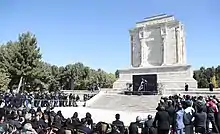
In March 2016, Shajarian revealed that he had had kidney cancer for the past fifteen years.[43] He appeared with shaved hair in his Nowrouz congratulation video, published on his YouTube account.[44] Bahram Beyzai composed a poem after announcement of Shajarian's illness and described it as a sad day in happy days of Nowruz.[45]
Shajarian transferred to hospital on 27 January 2020 and had a successful surgery.[46] He was released from hospital on 25 August but was hospitalized again on 5 October.[47][48]
Shajarian died on 8 October 2020 at the age of 80 at intensive care unit of Jam Hospital in Tehran.[49] The cause of his death was not immediately made public.[50] A private religious ceremony was held following day at Behesht-e Zahra in Tehran, before his body being transferred to Mashhad.[51] He was buried at the Tomb of Ferdowsi in Tus, Mashhad, on 10 October.[52]
Personal life
In 1962, Shajarian married teacher Farkhondeh Golafshan when he was 21 years old. They had one son Homayoun and three daughters, Farzaneh (a.k.a. Raheleh), Mojgan and Afsaneh. Afsaneh married Parviz Meshkatian. Shajarian and Golafshan divorced in 1993.[53]
His second marriage was to Katayoun Khansari, sister of his son's wife in 1995. The couple had one son, Ryan who was born in 1997 in Vancouver, Canada.[54]
Awards and distinctions
- NIRT Golden Cup (1977)
- Golden Picasso Medal (1999)
- Nominated for Grammy award in Best World Music (2004, 2006)
- Nushin Medal (2008)
- The UNESCO Mozart Medal[55] (2006)
- One of NPR's 50 great voices.[56] (2010)
- French National Order of the Legion of Honour (2014)
- National Order of Merit (2014)[57]
- Aga Khan Trust for Culture (2019)[58]
References
- BBC Persian Service: Mohammad Reza Shajarian Passes Away Retrieved 8 October 2020.
- Master of Persian Classical Music: Mohammad Reza Shajarian Retrieved 23 December 2017.
- "Mohammad Reza Shajarian". Archived from the original on 17 October 2007. Retrieved 28 October 2007.
- "Asia Society Presents: Mohammad Reza Shajarian, Classical Music of Iran". Asia Society. 2 September 1998. Archived from the original on 15 October 2007. Retrieved 28 October 2007.
- Davison, Phil (12 October 2020). "Mohammad Reza Shajarian, classical singer revered in Iran, dies at 80". The Washington Post. Retrieved 27 November 2020.
After the Iranian city of Bam was ravaged by an earthquake in 2003, killing more than 26,000, he organized a benefit concert for survivors and families of the victims.
- Ramin Mostaghim in Tehran and Borzou Daragahi in Beirut (6 September 2009). "IRAN: Famous singer Shajarian decries 'Language of Fire,'". Los Angeles Times. Retrieved 23 December 2017.
- "Mohammad Reza Shajarian: Iran's legendary singer dies in Tehran". BBC News. 8 October 2020.
- Tsioulcas, Anastasia. "A Voice Of Iran, Master Singer Mohammad Reza Shajarian, Has Died". NPR.org.
- Brehmer, Marian (9 October 2020). "Mohammad Reza Shajarian embodied the timeless beauty of Persian music". The Guardian.
- زندگینامه
- "استاد شجریان در سوگ مادر". همشهری آنلاین. 9 July 2007.
- محمدرضا شجریان درگذشت + آخرین عکس و علت فوت
- محمدرضا شجریان، خواننده ای که تکرار نشد
- Interview with BBC Persian
- واکنش معاون اسبق وزیر ارشاد به ثبت ملی ربنای شجریان: «...تا ابد افسانه تو پایدار»
- زندگینامه: محمدرضا شجریان (۱۳۱۹-۱۳۹۹)
- زندگینامه: مژگان شجریان (۱۳۴۸-)
- "Shajarian strides across world music stage". The Vancouver Sun. 1 May 2008. Archived from the original on 4 June 2011. Retrieved 4 February 2010.
- آشنایی با گروه شهناز
- Majid Kazemi - In Koja O An Koja (Adrenalism Album)
- Staff, IFP Editorial (8 October 2020). "Iranian Maestro Mohammad-Reza Shajarian Dies at 80". Iran Front Page. Retrieved 12 October 2020.
- خسرو آواز ایران است او ...
- درباره محمدرضا شجریان | خسرو آواز و اعتبار موسیقی ایرانی در جهان
- "شاگردان شجریان از استاد میگویند" [Shajarian's students talk about the master]. asrpress.ir (in Persian). 3 January 2017.
- "کافه نوا - فصل 1 قسمت 2: محمد اصفهانی". فیلیمو.
- "گزارشی از نمایشگاه سازهای ابداعی محمدرضا شجریان | موسیقی ما". www.musicema.com. Retrieved 12 January 2021.
- "Musical Instruments & Inventions". Mohammad Reza Shajarian. Retrieved 12 January 2021.
- دو شب از کنسرت چهره به چهره ، جشن هنر شیراز سال ۵۶
- گلبانگ شجریان
- آستان جانان
- پیوند مهر ـ محمد رضا شجریان ـ فرهنگ شریف و جهانگیر ملک
- بیداد
- نوار دود عود
- [music.iranseda.ir/DetailsProgram/?VALID=TRUE&g=109578 چکاد]
- زمستان است
- بي تو به سر نمي شود/ گزارشي از برگزاري كنسرت هاي استاد محمد رضا شجريان در خارج از كشور
- سخنرانی محمدرضا شجریان در دانشگاه کالیفرنیا
- نامه اعتراض آمیز شجريان به ضرغامی
- "محمدرضا شجریان: انتقادم به اشتباه یک فرد بود، با نظام مخالف نیستم". tabnak.ir (in Persian). 6 June 2016.
- www.alef.ir https://www.alef.ir/news/3990719079.html. Retrieved 14 November 2020. Missing or empty
|title=(help) - "استاد شجریان در آخرین مصاحبهاش: وقتی مردم دردی دارند من باید از درد دل آنها بگویم". روزنامه دنیای اقتصاد (in Persian). Retrieved 14 November 2020.
- "ناگفته های استاد شجریان در گفتگو با "ایران"/ سه سال خانه نشین بودم که بگویم توده ای نیستم/ " ربنا " چگونه خوانده شد؟ / نمی دانم حرف حساب افراطیون چیست؟/ یک هنرجوی خوب ابتدا باید بتواند خوب تقلید کند". ایران آنلاین. Retrieved 14 November 2020.
- Rudaw – Iran’s iconic singer Shajarian hints at cancer, refers to illness as ‘old friend’
- چرا استاد شجریان با سر تراشیده پیام نوروزی داد؟ + ویدیو
- یادداشت بهرام بیضایی برای تولد محمدرضا شجریان
- "بستریشدن شجریان در بیمارستان؛ "عمل جراحی موفق بوده است"". رادیو فردا.
- "استاد محمدرضا شجریان از بیمارستان مرخص شد". همشهری آنلاین. 24 August 2020.
- "بستری شدن دوباره استاد محمدرضا شجریان در بیمارستان؛ "خسرو آواز ایران" در اغما | صدای آمریکا فارسی". ir.voanews.com.
- "Legendary Iranian singer Shajarian passes away". Mehr News Agency. 8 October 2020.
- "Mohammad Reza Shajarian: Iran's legendary singer dies in Tehran". BBC News. 8 October 2020. Retrieved 8 October 2020.
- Paying tribute to Iran’s legendary maestro
- Fassihi, Farnaz (8 October 2020). "Mohammad Reza Shajarian, Iranian Master Singer and Dissident, Dies". The New York Times. Retrieved 8 October 2020.
- همسر استاد شجریان در مراسم تشییع + عکس
- "گفت و گویی با خانم کتایون خوانساری- همسراستاد شجریان". iranianuk.com. 8 October 2020.
- روزنا Retrieved 23 January 2007.
- Steve Inkeep (2 September 2010). "Mohammad Reza Shajarian: Protest Through Poetry". NPR. Retrieved 23 December 2017.
- وقتی شجریان، شوالیه فرانسوی ها شد +تصاویر
- جایزه ویژه بنیاد آقاخان به محمدرضا شجریان تقدیم شد
External links
| Wikimedia Commons has media related to Mohammad-Reza Shajarian. |
- Official website
- Delawaz Records website with pages of biography, discography, news and schedules of Shajarian.
- Mohammad Reza Shajarian and Radif
- Shajarian Receives UNESCO's Mozart Medal
- Mohammad-Reza Shajarian The Master Rebel
- Mohammad Reza Shajarian: Protest Through Poetry from NPR's "50 Great Voices" series
- Artwork inspired by Mohammad Reza Shajarian Artwork inspired by Mohammad Reza Shajarian
- Mohammad-Reza Shajarian discography at Discogs
